Hare Hills, Sand Hole or Pinch-belly Park?
The Glossop-dale Chronicle and North Derbyshire Reporter of 29 November 1901 published an article about the Glossop of a hundred years earlier. This recounted that a path came from Whitfield Cross, through the Little Moor, and passed through the Hare Hill Wood to Shepley Mill and Wren Nest Farm. Hare Hill Wood extended from St. Mary’s Road to King Street, and was a favourite spot for prize fighting. The area became known as the Sand Hole because of the sandy soil found there. At that time the Chapel en le Frith to Enterclough turnpike was new. Shepley Mill and Bridge End Mill had been built in the 1780s but it would be several years before most of the streets of Howardtown and Whitfield would be built. An article in the Glossop-dale Chronicle and North Derbyshire Reporter of 16 May 1874 mentioned that the trees of Hare Hill Wood were there until the work undertaken during the Cotton Panic. The clip from the 1857 map, below, does not show the trees but does show that the area was undeveloped.
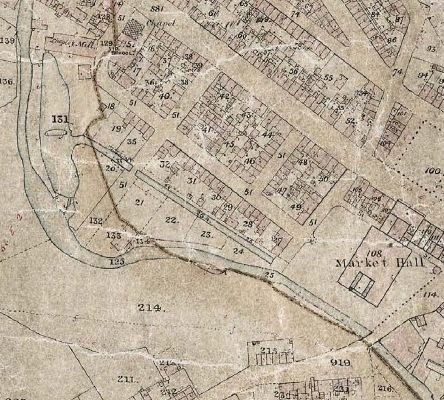
The Cotton Famine resulting from the American Civil War caused a great deal of unemployment, and consequent hardship, in Glossop.
A letter published in the Glossop Record of 9 May 1863 suggested that men might be employed on development of the area, to the advantage of the town: Some time ago, I noticed in your columns a copy of a memorial to Lord Edward Howard, praying for the opening of a thoroughfare from Whitfield to the bottom of Talbot-street. That is now happily an accomplished fact, to the great advantage of those requiring to use it. Between that new road and the brook below there is a plot of ground, which cannot be leased for building, but which, with a little of the labour now, alas, so plentiful, might be made an ornament to the town, instead of its being, as now, an eyesore and a nuisance in the neighbourhood. I allude to what is called the “Sand Hole”, lying along the south side of the brook, between Victoria Bridge and St. Mary’s (the Catholic chapel and school). If the streets in this vicinity were laid out, the crown of the hill reduced to its permanent level, and the slope down to the brook arranged as a public garden or promenade, with walk above walk on the hill side, and interspersed with flowers, shrubs, &c., an effect would be produced which would please every beholder; and if, in addition to this, a rustic fancy bridge was thrown over the brook, as a continuation of George-street, it would be all the better, and render its access all the more easy from High-street. Any one doubting the feasibility of this plan has only to inspect the garden of Mr. Holdgate to be convinced of its utility and practicability.
At the meeting of the Board of Guardians on 28 May 1863, the Chairman of the Outdoor Labour Committee reported that he he had had a conference with Mr. Hawke, Lord Edward Howard’s agent, about finding some labour for the men, and he had agreed that they should be set to work on the Hare Hills, together with other schemes.
The original payment rate of 3d per hour, decided on because of lack of available funds, caused a great deal of dissatisfaction as it was so low. The men on the Labour Test marched to the workhouse and a deputation of them asked for an increase, which was initially refused.
The Public Works Committee, at its meeting on 23 February 1864, heard that there had been six men employed in levelling on the Hare Hills, to whom £1 12s. 3d. had been paid. It was the lowest average paid, only amounting to 1s. per day. It was the usual rate for that type of work but far less than the men were used to earning in the mills.
By the following week the average earnings of the men employed at Sandhole had increased to 2s. 2½d. per day. The work continued until July 1864 and the number of men employed increased to 25 at its maximum but they still earned no more than between 2s. 3d. and 2s. 9d. per day.
As a result of the low rate of payment, Sandhole gained the name Pinch Belly Park.
The work which took place during 1863-4 created a road (really a pathway) across the Sandhole which was bordered on both sides by allotments. The road was the subject of numerous complaints during the years either side of the turn of the century because of the state it was in and the difficulty of having it repaired, either by Lord Howard or the council because of questions of ownership. The clip from the 1879 map, below, shows the “Roman Road” (as thought at the time) along “top Sandhole” and the road/pathway created in 1863-4 above it with the land divided into allotments.
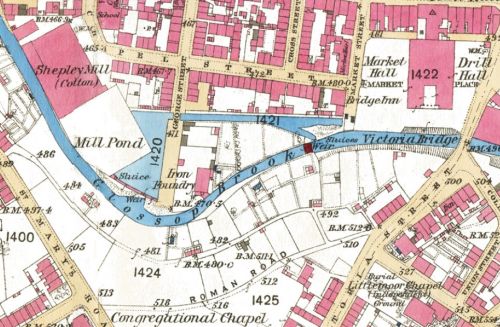
A letter in the Glossop-dale Chronicle and North Derbyshire Reporter 23 October 1886, headed The Road Known As “The Hare Hills” Glossop, read: I am sure that many of your readers will agree with me that the above road is in a very bad state. I have heard of several ladies who have gone ankle deep in mud or water, and considering the fact that the winter months or dark nights are upon us, it is time something was done. I understand this road is not yet dedicated to the borough. Complaints are continually being made by people who have to travel this way. I think a lamp placed about half way would also, with the improvement of the road, be a great boon to the inhabitants of this district There is an amusing story told by the old inhabitants of this district that a flying serpent was once seen flying from Shepley Mill over Shepley Mill lodge, in the direction of this road, but it shied off (as many of us do now), the only difference being it has never been seen since. I think it time the proper authorities give this road that kind attention which it requires. Surely the property owners will not have to send a deputation to the authorities respecting this matter? Yours truly, Plato.
The council did consider lighting the road and raised that question and the need for repair of the road with Lord Howard. A meeting of the Lighting Committee on 26 January 1887 received a letter from Francis Hawke: Lord Howard of Glossop, has pleasure in assenting to the request of your Committee to lay gas mains and erect lamps along the footway, through the above, from Victoria Street to St Mary’s Road. The repair of the footway should be at the cost of the public, by whom it is mainly used. As his lordship has been maintaining several miles of roadways used by the ratepayers, the dedication of which is refused, he is unwilling to extend his operations in this way.
The estimated cost for laying gas mains along the 200 yard long footpath, and erecting two gas lamps, at a distance of 86 yards from each end was £13 1s. 4d.
Councillors objected to the Corporation repaving any of Lord Howard’s roads until they were put in thorough order because, if they did so, the corporation would make themselves responsible for it. Some councillors were also of the opinion that other places in the borough were much more in need of being lighted. The photo below, taken from St. Mary's Road about 1887, shows the snow covered allotments and the 1863-4 road/pathway cutting through towards Victoria Street centre right. On the left is the iron foundry where George Street ended abruptly.
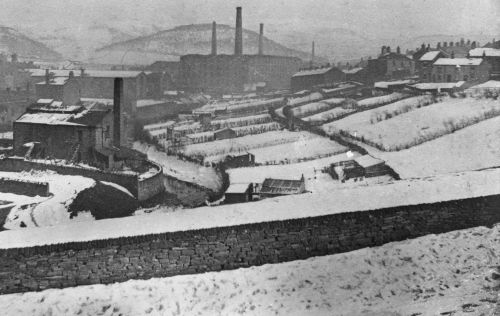
In the event, the council did light the Sandhole Road with gas in 1887 but that did not stop the complaints. The Glossop-dale Chronicle and North Derbyshire Reporter of 14 January 1888 included a letter reading: I see in looking over the report of the lest Council meeting that the Sand Hole Road has again come to the front, and the Council appear to think that something should be done in the matter. I am of the same opinion. The people in the district were very glad when the two lamps were placed on the road, and a many are very much annoyed that some mischievous persons have been damaging the fences. Since the lamps were put up there has been about 16 houses built close by, and others are asking for ground, and I understand that a company has already been formed and have purchased a greenhouse in the Sand Hole, and there is no doubt that these enterprising gentlemen may at some future time turn the Sand Hole into a park. Trusting that a good road will soon be made. I am, yours, One who well remembers the Flying Serpent paying a visit to this road.
The state of the road became the subject of an editorial in the Glossop-dale Chronicle and North Derbyshire Reporter of 1 September 1888: “Pinchbelly Park”, the appellation by which the Sandhole Road, or Hare Hills, Glossop, is more commonly known, has long been a vexed question with the large number of persons who daily traverse this ill-kept and not over safe thoroughfare. For some little time we have heard few complaints, but now angry growls are likely to reach the public ear as fiercely as ever. The gate, which for a lengthy period barred the St. Mary's-road entrance against vehicles, has, during the past week, been removed to the centre - one of the most dangerous spots on a dark night that could possibly have been found for it. Those travelling along this road, although aware of the fresh situation of the gate, yet labouring under the force of the adage that “use is second nature”, are wont in the darkness to “keep in the middle of the road”, in order to avoid precipitation to unpleasant depths below. The consequence is that while endeavouring to steer clear of one evil pedestrians plunge into another, with a shock only a few degrees milder than that with which the ship of Sir Ralph the Rover is supposed to have struck on the Inchscape Rock, and instantly all is confusion with wits and limbs. Two foot-passengers had “striking” examples of this the first night of the new arrangement, and having somewhat recovered from the sudden and not altogether painless proof of the gate's whereabouts, they scrambled to the top side of the path, intending to continue their way by means of the equally disadvantageous stile. Their troubles were not yet over, for scarcely had they found the opening, when the foremost, stepping on the clay-puddle mockingly situated there, came a cropper, knocking over his comrade with a rude but unintentional out-thrust of his legs. Fortunately, both escaped with a few scars, a great deal of slush adhering to their garments, and an inward feeling that they had either come in violent concussion with an iceberg, or had made the acquaintance of an erupting volcano.
We admit the danger of allowing vehicles along this road, and the desirability of a stoppage being put to their access, but why not prosecute one of the offenders. It would set an example to others who might be tempted to trespass, and probably obviate the necessity of hurting foot passengers' shins to say nothing of their feelings, and the eloquence elicited by a concussion with the gate. Anyway, for a time a lamp should be placed on the obstruction.
The situation did not improve and there were several cases of people tripping on the road. A letter in the Glossop-dale Chronicle and North Derbyshire Reporter of 25 November 1892 read: Sir, - Now that a very serious accident has happened on the “track” running between Victoria Street and St. Mary’s Road, known to many by the name of the Sandhole Road, to some by the highly euphonious name of “Pinchbelly Park”, and to others by the supremely euphonious and complimentary title of “Howard's Park”, it will not be out of place to ask who is responsible for the disgraceful and dangerous state in which it is always to be found. This road is used daily by a very large number of operatives and others, making it in point of importance equal to any thoroughfare in the town, with the exception of the main streets. Yet no road in the borough is so grossly neglected, and the Glossop roads are by no means paragons. Unfortunately the people who use it most are not of the wealthy or influential class, or the probability is that it would not be in its present discreditable condition. No pedestrian should venture to cross after dark, unless he is acquainted with every yard of the way. The accidents which have occurred in such cases are innumerable. A stranger attempting to steer across after sunset would run great risk of injury to limb, if not to life – t'would be safer were be on Kinder Scout. Had we but one councillor or alderman, or J.P., or lord of the manor, to tramp it from six to eight times daily, as hundreds of humble operatives and school children have to do regularly - often in the dark - the subject would have been raised in the Town Council long ago, and the duty of keeping the path in repair, and the dangerous parts properly fenced off, would have been rigorously enforced. Let our worthy councillors take the matter in hand as quickly as possible - none the less earnestly because the unfortunate individual referred to in the opening of this letter does not happen to be the wife of one of their fellow councillors. In the event of a fatal accident at any time (by no means impossible, or even improbable) on whose shoulders would the blame be laid? Surely something will now be done to remove the danger before we hear of any further accidents. — Yours, etc., Arthur Broyshard, Pikes Lane, Glossop, 23rd November, 1892.
The same issue of the newspaper carried a report of the meeting of the Highways Committee on 23 November at which Councillor Benjamin Platt enquired if the Corporation had anything to do with the repairing of the Sandhole Road. Several members apparently called out “No, no” and Councillor Rawsthorne said: If we commence repairing that road we will have our hands full. The road certainly is in a very dangerous state and a lady passing along there this week broke her leg. I think a letter should be sent from this committee to Lord Howard or his agent calling immediate attention to the dangerous state of the road, and requesting that something be done at once. Councillor Rawsthorne moved a resolution to that effect, and it was agreed to.
The meeting of the Council's Highways Committee on 7 December 1892 received a reply from Mr. Hawke: I have submitted your letter of the 24th inst. to Lord Howard. His lordship cannot accept the liability of repair. This footway differs from others in the neighbourhood. During the cotton famine in 1863-4, the Hare Hill Sand Pit, now called Sandhole, through which passed an old and dangerous footway, was greatly improved at the joint expense of Lord Howard and the Guardians of the Poor by the aid of funds obtained by the Manufacturing Districts Act 1863-4. The total cost to incurred was £211 17s. 3d., of which Lord Howard paid £175 and the Guardians £36 17s. 3d. Since then, so far as my memory serves, it has been repaired by both those parties. Lord Howard Is willing to share with the Highway Committee in the repair now required, so far as can be done by the laying of a drain or two across the road, covering the latter with cinders.
Councillors decided that as the road was lighted with gas they had done their part. The road did not belong to the Corporation, Lord Howard received the rent rolls and the council had nothing at all to do with it. It was agreed to send a reply stating that the Corporation have nothing to do with the road.
When the council applied for an order enabling it to install electricity cables, in November 1898, it included a number of roads which the council did not own or have responsibility to repair. The Sandhole Road was one of those included.
One of the other problems with the area was access from George Street. Hamnett tells us that there had been bridges but they were washed away by floods many times. Some contemporary reports tell of there being stepping stones rather than a bridge.
The Council's General Purposes Committee on 10 November 1901 discussed provision of a new bridge from the end of George Street. Councillors were generally in favour of it because of the convenience afforded to people living on both sides.
This wasn't the first time the subject had arisen and previously the surveyor had estimated that it would cost about £50 to £100. It was argued at the time that it would benefit Lord Howard and that he ought to pay his proportion of the cost. Lord Howard did not see that it would do so because there was no eligible land there for building. An alternative suggestion was to persuade Lord Howard to cover the brook course down to that point from the Market Tavern. That would have cost far more though. As usual the council decided that a committee be appointed to deal with the matter, to visit the site and and estimate the cost etc. of both suggestions, meeting with Lord Howard if necessary.
Notwithstanding the proposals for a bridge, complaints had continued to be made about the state of the road. There were also complaints about cyclists using the road and the eyesore created by the hen pens, allotments and ash tips which occupied the land.
The meeting of the General Purposes Committee on 5 February 1902 heard that the subcommittee appointed had inspected the “Sand Hole” that afternoon, and they had directed the Town Clerk to communicate with Lord Howard calling his attention to the state of the roadway and asking him to put it in reasonable repair.
At the council meeting of 19 February 1902 the Town Clerk read a letter received that evening from Lord Howard which did not address the complaints but in which his lordship stated that he intended to present to the town a foot-bridge to be placed over Glossop Brook at George Street on the following conditions: That the Council would undertake to transfer the said bridge from the railway tracks at Glossop Station (where it was in use at the time) to its proposed position at George Street; to erect two stone abutments/or the bridge to be placed thereupon, his lordship undertaking to give substantial stone for the said abutments. The proposed bridge would be 48 feet long and 5 feet wide and would have latticed girders and wooden floor. Councillors decided to accept the offer and to thank Lord Howard for his gift.
It was intended that the bridge be installed in time for the coronation (hence it being given the name Coronation Bridge) but the work wasn't actually completed until 1st October 1902. The photo below, taken in April 1912 from a similar position to the earlier one, shows the original Coronation Bridge. The foundry had been replaced by Isaac Jackson's engineering works which was later occupied by Glossop Glove Company. The newly built Electric Palace is to its left.
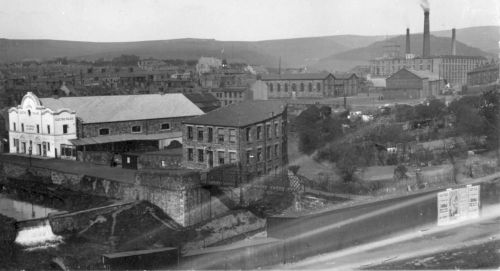
It has also been hoped that the Sandhole and its vicinity would be laid out as a public park as another special coronation feature, something which various people had been campaigning for over several decades but that was not to happen for more than 20 years.
In the intervening period some maintenance had to be undertaken. The Highways Committee in November 1909 approved extra timbering of the floor of the footbridge and painting of the railings with red paint. The bridge was repainted, following a request from Lord Howard's agent, in March 1912.
In December 1912 the council discussed the use of Sandhole for a tip and the types of material that might be suitable for tipping so close to the town centre. The council preferred that the site on Surrey Street (where the football ground now stands) be used.
The clip from the 1919 map, below, shows that Sandhole had changed little other then the bridge being at the end of George Street.
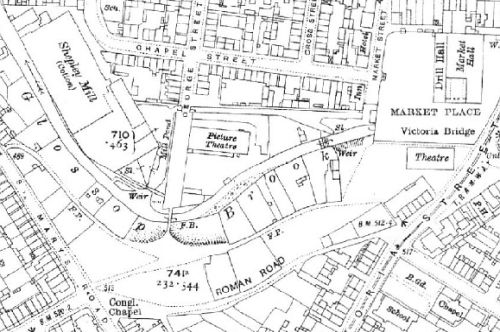
Following the end of World War 1 a committee was set up to create a memorial to the people of the town who had served. One of the suggestions was the revival of the idea of turning the Sandhole into a public park. The council was also keen to obtain land for housing from Lord Howard and he offered to donate the Sandhole if his preferred site for housing was agreed on. Agreement could not be reached immediately but the Sandhole improvement was part of development plans discussed by the council in October 1920. The proposals included a new road from Victoria Street to St. Mary’s Road and a bridge to it from Market Street, which was then a cul-de-sac with a slippery slope down to the brook. The Coronation foot-bridge at George Street was to be replaced by a new bridge and there would be a footpath along the river through gardens from Victoria Street to St. Mary's Road with branches into Brook Street and High Street West. Shrubberies would be created between the river and “top Sandhole”.
Further negotiations were held with Lord Howard but it was to be another year before agreement was reached, the gift being made as a memorial to Lord Howard's younger son, Lieutenant The Hon. Philip Fitzalan Howard who died in 1918, of wounds received in action and in appreciation of the services of the men of Glossop who served during the war.
In an echo of 1863-4, the levelling of the land for the construction of Philip Howard Road provided work for the unemployed during the winter of 1921 but further work was delayed by funding problems and the desire of the council to prioritise the extension of Surrey Street, south of Dinting station to Hadfield (another of the October 1920 proposals). Lord Howard was adamant that the work on Sandhole should be completed first. Some work did continue and the bridge connecting Philip Howard Road to Market Street was completed by November 1923. Work on Philip Howard Road continued to be delayed though and it was not until the end of July 1928 that it was finally opened. The works also included replacing the Coronation Footbridge with the concrete bridge which is still there.
The photo below was taken from the market ground on the day that Philip Howard Road and the new Harehills Park were opened. The new bridge does not show up well but is behind the lamp, just to the left of the Glove Works. The next two photos show the bridge under construction and the centre of the bridge following completion.


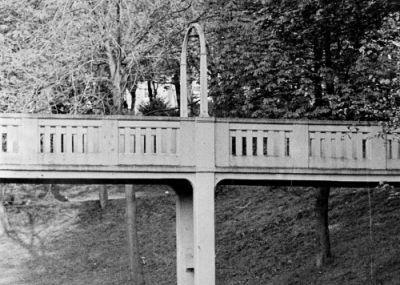
The road was further enhanced, in May 1939, by the provision of shelters which were gifted by Councillor and Mrs Farnsworth. The photo below was taken at the opening ceremony. About 20 years later improvements included the provision of rustic fencing along the road. Both shelters and fencing were subsequently removed.
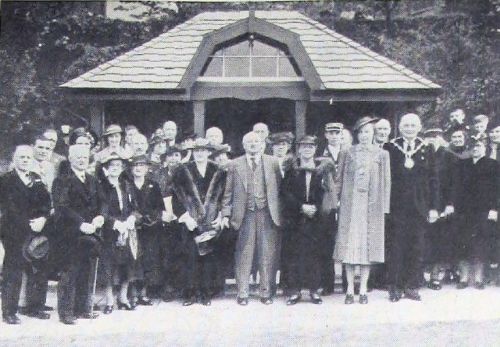
Return to GJH.me Home Page, Return to Glossop Area Local Histories index.
Last updated: 30 October 2022









